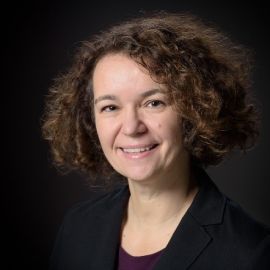Listen here on Spotify | Listen here on Apple Podcast
Episode recorded on July 19, 2023
Episode released on November 30, 2023
 Petra Döll is a Professor of Hydrology at Goethe University in Frankfurt. Her research focuses on global hydrologic modeling, particularly the WaterGAP model, and on transdisciplinary knowledge integration and participatory research methods. She has contributed extensively to IPCC reports.
Petra Döll is a Professor of Hydrology at Goethe University in Frankfurt. Her research focuses on global hydrologic modeling, particularly the WaterGAP model, and on transdisciplinary knowledge integration and participatory research methods. She has contributed extensively to IPCC reports.
Highlights | Transcript
- Germany has been subjected to summer droughts since 2018, as shown by soil moisture maps of the Drought Monitor Germany produced by Helmholtz Center for Environmental Research. These droughts impact agriculture, forests, and transport on the Rhine, and, to a less critical extent, also water supply.
- In 2022, the 25th anniversary of the global hydrological model WaterGAP (Water Global Assessment and Prognosis) was celebrated. WaterGAP development was initiated by Professor Joseph Alcamo at the University of Kassel, Germany, when Petra joined in 1996.
- WaterGAP simulates both water resources (runoff and groundwater recharge) and human water use to assess water stress under the impact of global change. The strong focus on simulating water use for irrigation, industry, and domestic uses made WaterGAP distinct from land surface models developed mostly by climate scientists.
- Globally, irrigation is the dominant water use: 90% of global freshwater consumption and 70% of global freshwater withdrawal are for irrigating crops (Siebert et al., 2010).
- Given the high uncertainty of climate and other information, WaterGAP was, from the beginning, calibrated to long-term mean annual streamflow so that reasonable estimates of water stress (e.g., the use-to-availability ratio) could be computed. Early work on water stress indicators by Falkenmark et al. (1989) only considered renewable water (limited to surface water) availability per capita.
- WaterGAP incorporated groundwater by estimating groundwater recharge as part of renewable water resources (Döll and Fiedler, 2008) and by distinguishing surface water and groundwater abstractions (Döll et al., 2012; Siebert et al., 2010). This enabled quantification of groundwater stress on both humans and river ecosystems (Herbert and Doll, 2019).
- WaterGAP does not include a gradient-based groundwater model but integration of such a model is currently ongoing.
- Comparison of simulated Total Water Storage Anomalies (TWSA, Surface water, Snow, soil moisture, and groundwater) from WaterGAP with GRACE is difficult because of leakage effects with GRACE. An earlier study shows large variability among global models and between global models and GRACE in terms of global water storage trends and seasonal variability (Scanlon et al., 2018, 2019). More recent comparisons between globally averaged globally averaged total water storage from WaterGAP and GRACE shows good correspondence regarding seasonality but overestimation of trends by 30 – 50% when considering water mass transfer from continents to oceans (1948–2016) (Cáceres et al., 2020). This made it possible to estimate the impact of groundwater abstractions on sea-level rise.
- To support society in making decisions related to sustainable development, it is not enough that scientists inform stakeholders about scientific knowledge; it is important to understand their problem perspectives and to integrate their knowledge with scientific knowledge. Petra became aware of this during a project on managing climate change risks in Northeastern Brazil around the year 2000, and consequently started to work on methods for transdisciplinary knowledge integration in participatory processes afterwards.
- Participatory methods that support the co-design of sustainable solutions with stakeholders include the elicitation and analysis of problem perception graphs and participatory Bayesian Network modeling (Düspohl and Döll, 2016).
- To be successful, participatory processes for managing the risks of climate change need to embrace uncertainties to be successful (Döll and Romero-Lankao, 2017). Important uncertaintyies include climate change hazards, e.g., how water resources may change in the future.
- Uncertainty in climate change hazards can be estimated by considering the range of changes computed by multi-model ensembles, communicated to stakeholders, and integrated into local decision-making tools (Kneier et al., 2023).



